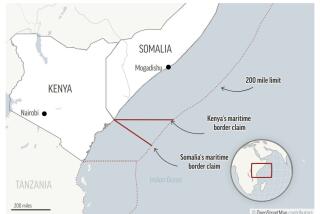Rangersâ Somalia Mission Marred by Lapses, Errors : Military: Troopsâ high-profile search for warlord Aidid went awry. That led to change in U.S. policy.
MOGADISHU, Somalia â Stripped to their shorts, their faces smeared with sun block, the crack commandos of the U.S. Armyâs 75th Ranger Regiment spent the last day of their ill-fated mission in Somalia on Wednesday locked in fierce combat--on the volleyball court.
Then, before the sweat dried, the first 100 quietly packed their bags, had a last look around and prepared to board a C-5 Galaxy for home today in a departure with no ceremony.
Asked how long he had been in this land that many Americans now want to forget, one of the 750 Rangers due to leave during the next few days under President Clintonâs orders to abandon their mission simply shook his head and said, âToo long.â
This was the end of the ambitious two-month effort by one of Americaâs most highly trained combat units to capture a single Somali warlord, Mohammed Farah Aidid. Plagued by miscues and misinformation and ending in disaster, it changed the course of the U.S.-led U.N. mission to save Somalia from self-destruction.
The hunt for Aidid--now likely to go free--has ended, Maj. Gen. Thomas Montgomery, commander of the U.S. forces in Somalia, made clear in interviews this week. And so has the messiest chapter in recent U.S. military history.
Sixteen Rangers were among the 18 U.S. troops killed, dozens more were wounded and one was held hostage for 11 days after 16 hours of fierce fighting on Oct. 3, which changed Americaâs mind about Somalia.
But U.N. military spokesman Maj. David Stockwell, himself a Ranger by training, tried to put the best possible face on the mission that the Rangers left half-done in this terrifying city. âThese guys did a great job. They were given an extremely difficult mission, in particular to detain Aidid,â he said. âWeâre not cops. Weâve been forced to adopt war-fighting technology to a fugitive hunt in a city of 1 million.â
In short, Stockwell said, it was Mission Impossible.
In reality, from its first operation to its last, the Rangersâ hunt for Aidid was plagued by bad intelligence, lapses in communications and insufficient coordination with the U.N. officers who command the 29,000 multinational peacemaking troops in Somalia. Taken together, the Rangersâ apparent missteps made their hunt for Aidid, a mission approved by the Clinton Administration when the best U.N. efforts were failing, appear more like a comedy of errors.
The Times learned in interviews with U.S. and U.N. military officers, civilian analysts and influential Somali eyewitnesses that the Rangers did score some successes, capturing four of Aididâs top aides and killing hundreds of his militiamen and hard-core supporters. But it was equally clear that miscalculations left a wake of ill will among Somalis that contributed to the vicious popular assault on the Rangers during the Oct. 3 battle that turned Americaâs stomach and changed its policy in Somalia.
The Rangersâ saga in Somalia began on a bad note with a raid on Aug. 30, four days after the first 400 members of Task Force Ranger arrived, that netted only eight âprisoners,â all U.N. civilian employees.
The intended target that night, as dozens of Ranger commandos slithered down ropes into a Mogadishu compound, was a house that U.N. intelligence officers thought was being used by Aididâs forces to direct mortar fire into the U.N. stronghold at the international airport. The mortar attacks were part of Aididâs guerrilla war on the U.N. mission after the special U.N. envoy declared him a wanted man for the June ambush that killed 24 Pakistani peacekeepers.
By the time the Rangers reached the house, though, it was empty. As they cleared the rest of the compound, which one U.N. military officer concedes they did not know included a U.N. Development Program residence, they forcefully detained and handcuffed the U.N. development workers. The workers represented half a dozen nations attempting to rebuild ruined Somalia.
The next day, the mishap was widely reported.
The most destructive raid--one that went largely unreported--was a Sept. 14 midday attack on a house that Rangers suspected was a hide-out for Aididâs top lieutenants. It wasnât: The house belonged to Somaliaâs police commissioner, Gen. Ahmed Jilow, one of the United Nationsâ greatest assets in its campaign to rebuild the Somali national police force. U.N. officials never told the Rangers that at the time.
âGen. Jilow was the U.N.âs closest ally,â said one U.N. military officer who asked not to be named.
The Rangers arrested Jilow that night. They also detained 38 other influential, pro-U.N. Somalis who were in the house at the time. All were released hours later when U.N. military commanders intervened.
In the process, the Rangers ruined Gen. Jilowâs four late-model cars, firing .50-caliber rounds into the engine blocks. They badly damaged his house, leaving a total of $100,000 worth of destruction for which the police chief is now demanding compensation from the United Nations.
The raid shook the confidence of the one force the United Nations sees as a foundation block for the future of a lawless land with no government: its nascent national police department.
Underscoring the Sept. 14 fiasco, U.N. military officers confirmed that the Rangers, who operated well outside the U.N. command structure, actually had consulted U.N. commanders shortly before the raid. But those commanders authorized the operation without consulting U.N. officers who knew that the house belonged to a key ally.
There were other episodes. During one raid, a Ranger on an assault-and-extraction team that dropped from helicopters into another house asked the owner if he was Aidid. The man answered, âNo.â The Ranger hit him with his rifle butt and asked him again. Terrified, the man answered, âYes, Iâm Aidid.â He was arrested.
The Rangersâ greatest success--one of just two âclearly clean missions,â in the words of one U.N. officer--was the detention of Aididâs financial manager, Osman Atto. It came on Sept. 21, just three days after the Rangers assaulted Attoâs garage, only to watch from a distance as their target âscurried through a hole in the wall like a rat,â as one Ranger described the scene.
Following a tip from an insider in Aididâs Somali National Alliance, a Ranger surveillance helicopter spotted Atto in his car and started tailing him from the air. Atto saw the helicopter and apparently panicked. He ducked into a house near Digfer Hospital, an Aidid stronghold in southern Mogadishu. The Rangers reacted fast. Six helicopters and 50 commandos quickly scrambled, hit the house amid a barrage of fire and captured Atto and his three bodyguards without a single casualty.
âThis shows just how difficult it is,â Maj. Stockwell said. âWe canât get on the ground and watch them. Weâve had to do this from the air. . . . We rely on Somali intelligence, which is always tenuous at best. You do the best you can with what youâve got.â
The logistics of tracking a single man in a city that is a heavily armed maze of broken streets, gutted houses and neighborhoods that the U.S. military has designated as âno-go areasâ were only one aspect of the Rangersâ nightmarish mission.
âCommunication and coordination between the U.N. and the Rangers was a big problem in some cases,â one U.N. officer said.
Part of the problem, said Gen. Montgomery, who commands U.S. forces in Somalia, is that U.N. officials had no command control over the Rangers, who were under the direct authority of an unnamed U.S. Army major general within the Ranger Task Force in Somalia, who reported directly to superiors in the United States.
After their embarrassing debut on Aug. 30, Ranger officers did check with U.N. commanders before each of their seven subsequent major raids to determine the exact identities of their targets. But those checks often were made just minutes before the raids were launched, and there often was too little time for a thorough confirmation.
The Rangersâ final and deadliest raid, the assault Oct. 3 on an Aidid stronghold near Mogadishuâs Olympic Hotel that left 18 American soldiers and at least 300 Somalis dead, was also the most dramatic example of that poor coordination.
The United Nations had identified that compound as one of the most difficult targets in the city. Yet the Rangers went ahead with their usual helicopter-borne assault in broad daylight in a neighborhood that had no safe landing zones.
The raid was a partial success: Nineteen of 21 Aidid supporters were captured by the Rangers.
But many of the key detainees are likely to be freed if the political negotiations soon to begin between the United Nations and Aididâs representatives succeed in brokering a political solution.
It was difficult for the Rangers to speak in their own defense on the eve of their departure: Their task force includes the most secretive elements in the U.S. military. In an interview several days ago, however, the 75th Ranger Regiment commander, Lt. Col. Danny McKnight, told several American journalists that his men will leave Somalia with their heads high.
âWe were successful. . . . We did accomplish our mission,â he said, describing the overall task as one of making Mogadishu safer for the United Nations. âEvery soldier who is out fighting his tail off deserves to have the recognition that they were here doing what they were told to do.
âThose soldiers who died, died doing the right thing. Those guys who died were heroes.â
More to Read
Sign up for Essential California
The most important California stories and recommendations in your inbox every morning.
You may occasionally receive promotional content from the Los Angeles Times.










